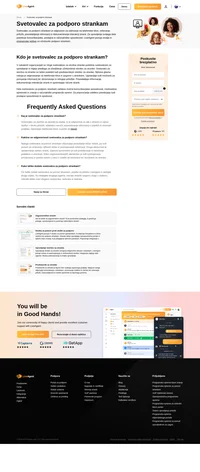Have you ever wondered what the difference is between a service desk and a help desk? These terms are often misinterpreted or interchanged, but they actually have some key differences that you need to keep in mind.
Therefore, we are going to dive into what exactly a help desk and a service desk are, explore their unique features, and discuss which one might be most suitable for your business. By the end of this article, you’ll have a clear understanding of these terms and be able to choose the right tool for your business needs.
Table of Contents
What is a help desk?
Picture a help desk as a virtual support center that acts as a bridge between businesses and their customers. It’s a support software that gathers customer queries and tackles them effectively. Acting as a central point for customer service, it lets businesses sort, monitor, and solve issues or requests from multiple channels such as emails, live chat, or social media.
Help desk as a service can greatly enhance customer and employee satisfaction by streamlining the process of handling customer issues in a timely and organized manner. It allows businesses to provide efficient support and maintain a positive brand image by ensuring prompt responses and resolutions to customer problems. All this is possible thanks to its advanced features that extend its usefulness.
Help desk or helpdesk? If you are wondering what the difference is between helpdesk vs help desk, it lies in how the terms are commonly used.
- Help desk is used to describe a customer support function or a dedicated team responsible for resolving customer inquiries. The term is often used in the context of IT support, where a help desk team assists with technical problems.
- Helpdesk is often used as a synonym for “help desk.” However, it can also refer to the software or system used to manage and track customer inquiries, tickets, and support interactions.
What is a service desk?
A service desk is similar to a help desk, but it goes beyond just addressing customer inquiries. It serves as a comprehensive IT service management (ITSM) solution that provides support not only to customers but also to employees. The ITSM help desk is a part of the service desk that provides efficient management of IT service-related incidents, requests, changes, and problems. It ensures that IT service management processes are followed and enables the service desk to deliver high-quality support. One of its essential components is the IT service desk ticketing system, which helps in organizing and tracking user requests.
Unlike a help desk, which primarily focuses on customer support, a service desk focuses on a broader approach. It manages and coordinates IT services for the entire organization, ensuring smooth operations, minimizing downtime, and enhancing productivity. It is also responsible for managing service level agreements (SLAs), incident tracking, and service request tracking, and even facilitating internal communication among teams or departments.
Help desk vs service desk: What’s the difference?
When explaining the difference between a help desk and a service desk, it’s important to note that despite sharing some features, they have several distinct characteristics.
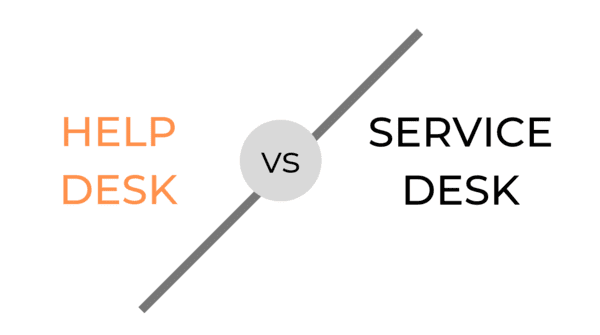
User-centricity vs business-centricity
The primary function of a help desk is to handle incidents and service requests. Help desks aim to resolve customer issues quickly, ideally on the first contact, to reduce overall wait times. Efficient request handling is at the core of help desk activities for many organizations. Therefore, the help desk is concerned with end-user functionality.
On the other hand, the service desk software focuses on the needs of a business rather than the user’s needs/requests. Instead of simply responding to incidents and fulfilling requests, a service desk reviews the overall IT and business processes within an organization with the goal of continual improvement. Ultimately, service desks focus on business goals and best practice processes.
| Key differences | Programska oprema za pomoč uporabnikom | Programska oprema za službo za podporo |
|---|---|---|
| Main features | A help desk generally includes a ticket management system and self-service capabilities. | A service desk includes modules for incident, problem, change, knowledge, and asset management. |
| Issue resolution | A help desk is tactical and reactive. | A service desk is strategic and proactive. |
| Main focus | A help desk focuses on solving the problem of end-users. | A service desk focuses on a long-term service strategy. |
| Main approach | A help desk operates on a break-fix issue approach. | A service desk operates on a holistic approach that is aligned with business goals. |
| Required resources | A help desk can often be run with minimal staff. | A service desk usually requires more human resources. |
Help desks are a subset of service desks
The biggest difference between a help desk and a service desk is that the help desk can literally be considered a subset of the service desk due to the tool’s limited scope and capabilities. Help desks typically have a narrower scope and focus mostly on customer support. They handle specific types of issues, such as troubleshooting technical problems or answering customer inquiries.
A service desk offers a broader range and more complex services. This is in addition to ticket management and the integration of business processes into the service management infrastructure. Most of the service desk software systems on the market can be used as help desks. However, it does not apply the other way around. Many organizations incorporate the help desk as a part of their service desk.
Stand-alone solution vs integrated solution
A help desk is a stand-alone solution performing tasks related to ticket management, allowing businesses to track and prioritize customer inquiries. It also offers knowledge management in the form of a self-service functionality which enables customers to find answers to their questions by themselves.
A service desk is a more complex system with a full range of IT management capabilities. It is integrated with other IT service management processes and is capable of providing advanced services such as change management, release management, asset management, configuration management database (CMDB) management, and more. When integrated, it can create a unified solution for managing IT services within an organization.
Reactive vs proactive
Help desks are designed to quickly address users’ immediate problems. They primarily function as break-fix solutions for when things go wrong—users report issues through a ticketing system, which is then addressed. This means help desk ticketing systems are reactive, responding to problems as they arise.
Although service desks perform certain reactive tasks as well, their major function is to proactively ensure that IT operations run smoothly. This may involve monitoring systems and identifying potential issues before they can escalate. A proactive approach can help minimize disruptions and maximize efficiency.
5 Key benefits of help desk and service desk tools
Easy ticket handling
Both help desk and service desk tools offer the benefit of easy ticket handling. When customers or employees raise an issue or request assistance, these tools allow businesses to manage and handle these tickets efficiently.
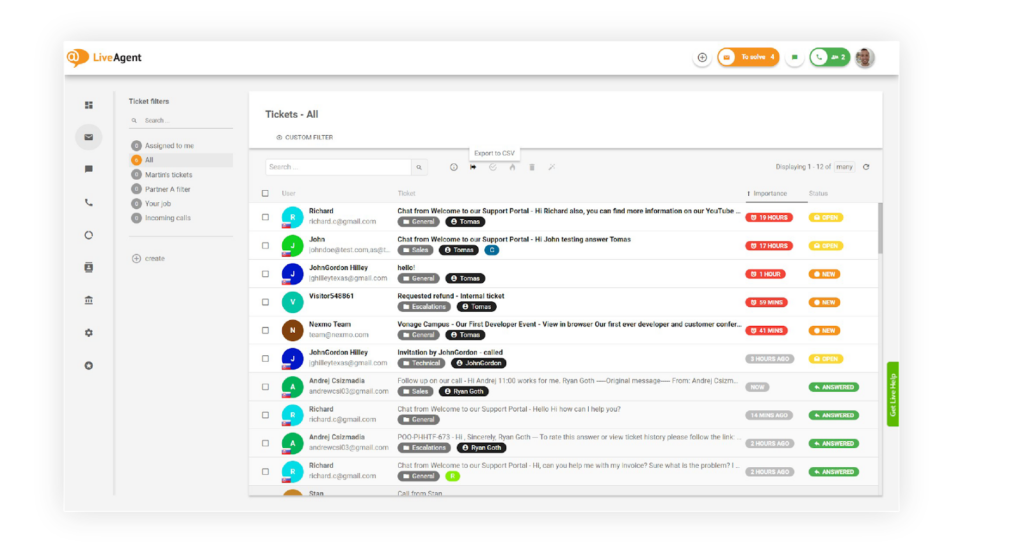
- Streamline support processes.
- Provide a centralized platform to receive, track, and prioritize tickets – ensuring that no requests are overlooked or lost.
- Easily assign tickets to appropriate departments/agents, set deadlines, and keep all communication related to the ticket in one place.
- Avoid miscommunication, reduce response times, and improve customer satisfaction.
- Features like automated ticket routing, categorization, and escalation make it easier for customer service teams to manage and prioritize their workload.
- Handle a larger volume of tickets effectively.
Clear communication
Another benefit of help desk and service desk tools is facilitating clear and effective communication between the support team and the customers or employees.
- Have access to a centralized communication channel where all interactions related to a ticket are recorded and easily accessible.
- Ensure that all relevant stakeholders are kept informed and updated throughout the ticket resolution process.
- Track the progress of all requests, receive notifications about any updates or changes, and have a clear understanding of when to expect a resolution.
- Enhance customer satisfaction and improve internal communication.
- Help your team collaborate effectively to resolve issues, share relevant information, and provide a consistent and unified support experience.
Fast workflow and problem-solving
By having a centralized platform to manage tickets, businesses are able to establish efficient workflows because of effective ticket prioritization. Help desks and service desks typically include features like ticket categorization, assignment rules, and automated workflows. These tools assist in directing tickets to the appropriate team members, ensuring they’re resolved promptly.
- Track the progress of each ticket, identify bottlenecks, and take necessary actions to keep the process moving.
- Ensure faster response and resolution times, improve customer satisfaction, and minimize any negative impact on business operations.
- Encourage self-help by providing knowledge bases and self-service portals. These resources allow customers or employees to quickly find answers to common questions.
- Accelerate the problem-solving process.
Multichannel support
Multichannel support refers to the ability of help desk and service desk tools to receive customer inquiries and provide support across multiple communication channels. This includes more traditional channels like phone and emails, as well as newer channels like live chat, social media platforms, and even mobile apps. According to statistics, 6% of customers prefer contacting support through email, 65% prefer phone, 53% website support such as live chat, and around 48% prefer in-person support.
- Cater to the diverse preferences of customers, and allow them to choose their preferred communication channel for contacting support.
- Provide a seamless support experience by meeting your customers where they are.
- Access and respond to tickets from different channels in one place without the need to switch between multiple platforms or systems.
- Help desks and service desks can be integrated with various communication channels, bringing them under one roof (for example: phone calls can be routed through a help desk system, live chat widgets can be embedded on websites, and social media interactions can be monitored and managed within the tool).
Centralized knowledge base
A centralized knowledge base is a well-organized, searchable repository of valuable information. It includes resources like guides, articles, FAQs, troubleshooting tips, product documentation, videos, and other support-related content. According to research, more than 81% of customers try to solve their problems independently before reaching out to customer support because it takes less time and effort. Therefore, the content should be concise, easy to understand, and relevant to help users find the information they need.
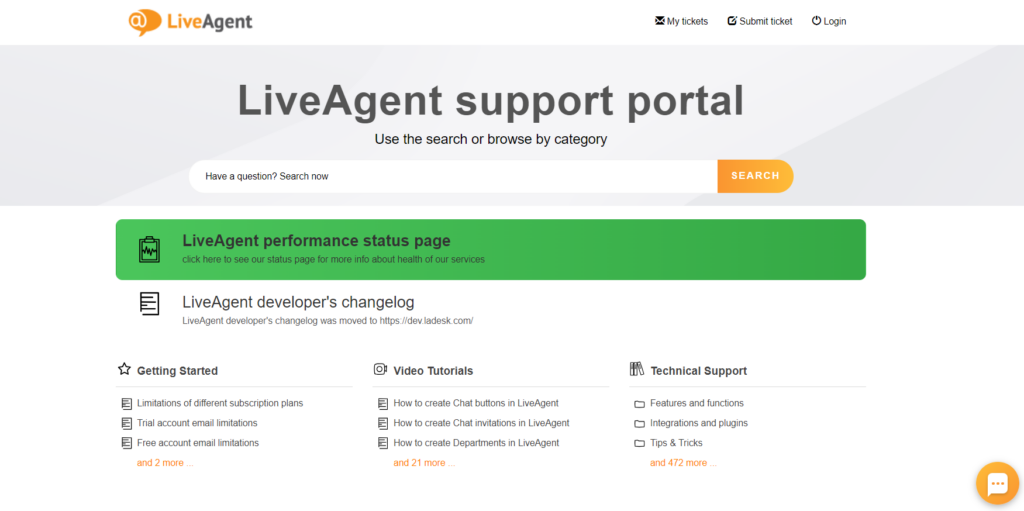
A knowledge base can be highly beneficial to:
Customers:
- Customers can access the knowledge base through self-service portals or websites, enabling them to find answers to their questions or troubleshoot common issues without contacting support.
- It saves them time and effort by providing instant access to information, reducing the wait time before support agents respond.
- A well-structured knowledge base can enhance the customer experience by empowering them to solve problems on their own and feel more engaged with the brand.
Support agents:
- Agents can use the knowledge base as a valuable resource during customer interactions, enabling them to quickly find precise and up-to-date information.
- It helps them provide consistent and accurate responses.
- They can also contribute to the KB by sharing their expertise and documenting their processes, which enriches the knowledge base and benefits the entire support team.
Employees and internal teams:
- A centralized KB provides access to training materials, onboarding documentation, and internal processes, fostering a culture of knowledge-sharing and continuous learning.
- It assists different departments within an organization, such as sales, marketing, and operations by keeping them informed about new product updates, features, or important company policies.
If you want to learn more about help desk software and its benefits, you can check our separate article regarding this topic.
Help desk or service desk: which one do you need?
When it comes to choosing between a help desk and a service desk, it’s important to consider your specific industry, the size of your business, the scale of your operations, and your specific needs.
Help desk software
- Suitable for small to medium-sized businesses or those focused primarily on customer support.
- Great for industries such as e-commerce, software-as-a-service (SaaS), retail, hospitality, or any business that deals with a significant volume of customer inquiries.
- If you are dealing with a large number of customer inquiries, a help desk can assist you with efficiently tracking and managing tickets.
- For those whose main goal is to ensure effective customer communication and provide prompt solutions to customer inquiries.
Our tip: When choosing between help desk software, look for essential features like ticket management, automation, easy integration with other tools and communication channels, and a user-friendly interface that supports efficient customer service.
Service desk software
- It is a more comprehensive solution, ideal for larger enterprises or organizations with complex IT service management needs.
- Large organizations with multiple departments and diverse IT infrastructure can benefit from the advanced capabilities that ensure effective coordination across the business.
- Suitable for industries such as healthcare, finance, IT services, or any business where internal IT support and coordination are crucial.
- If you are looking for capabilities beyond just customer support, such as incident management, asset management, service level agreements (SLAs), and change management, a service desk software will be a better tool for your needs.
Our tip: When choosing a service desk software, look for features like ITIL compliance, inventory management, service catalog, and robust reporting capabilities to manage and optimize your IT services efficiently.
6 things to do when choosing the right tools
Selecting and investing in the right type of software is important. With countless options available on the market, it’s important to approach the selection process strategically. Therefore, we want to give you some key considerations and steps to follow when choosing the right tools for your business needs.
Assess support complexity
The level of support complexity can vary depending on factors such as the size of your company, the type of industry you operate in, the volume of incoming customer inquiries, or your IT service management requirements. Therefore, choosing a tool that matches your support complexity will ensure that you have all the necessary features and integrations to manage your operations. Taking this into account can minimize the risk of outgrowing the tool as your needs evolve.
The complexity of support can impact your choice in several ways:
- Feature requirements: If your support needs are relatively straightforward, a help desk tool may be sufficient. However, if you have complex IT service management requirements, a service desk tool with advanced functionalities would be more suitable. In either case, don’t forget to provide proper employee training to ensure that your team can effectively utilize the tool and maximize its potential.
- Workflow management: Complex processes often require more advanced workflow management capabilities. Service desks typically offer more advanced workflow automation features, allowing you to automate complex ticket routing or assignment processes. Help desks may have more limited options, better suited for simpler workflows.
- Integration with other tools: If you have a complex IT infrastructure and need to integrate the support tool with systems like asset management, monitoring tools, or CMDB, a service desk tool will likely provide better capabilities.
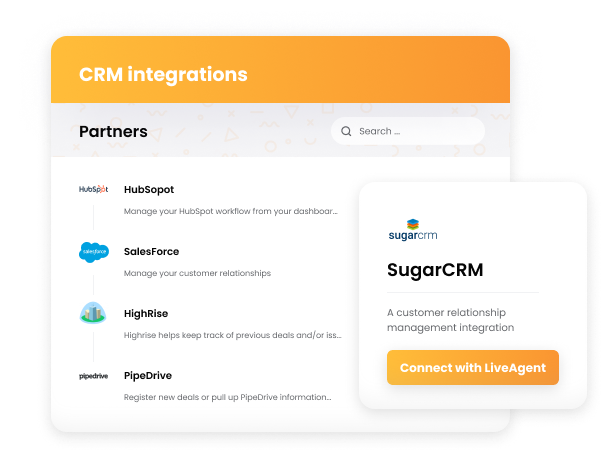
Explore automation options
Automation can significantly improve the efficiency and effectiveness of your operations because it allows you to reduce manual tasks and deliver faster resolutions. Here’s why you should consider automation:
- Efficiency and productivity: Automation can accelerate routine tasks, freeing up time for support agents to focus on more complex issues. By automating processes such as ticket routing or ticket assignment, you can ensure that all tickets are assigned to the right agents, reducing response and resolution times.
- Consistency: Eliminate human errors and inconsistencies that can occur in manual processes. Automation ensures consistent adherence to service level agreements (SLAs) and accurate tracking of ticket progress.
- Proactive support: You can provide proactive support by setting up trigger alerts or notifications for specific events or conditions. This allows you to address issues before they escalate, minimizing downtime and maintaining a high level of service availability.
Plan for growth
It’s also very important to plan for the future and consider the potential growth of your business. The software you choose should be capable of accommodating your growing needs.
- Business growth: As your business grows, your support operations will more than likely experience an increase in incoming inquiries or management requirements. Therefore, you need a tool that can handle the growing volume of tickets, additional users, and more complex workflows. However, keep in mind that as your business grows and you require more from the tool, it may affect the pricing structure.
- Scalability: Don’t forget to consider scalability factors such as user and ticket capacity, performance and response times, integration flexibility, and customization options. The tool you choose should be able to handle both your current needs and accommodate future growth. It should also be able to integrate smoothly with other systems and offer customization capabilities to adapt to evolving business requirements.
Gather user feedback
Gathering feedback provides valuable insights into the experiences and perspectives of current users, helping you make a decision about which tool will best meet the needs of your business. Here are some reasons why gathering user feedback matters and why it should be a consideration when choosing between help desk and service desk tools.
- Real-life user experience: Feedback from users provides real-life experiences from those who are actively using the tool. This can give you a better understanding of the tool’s strengths and weaknesses. It helps you get a more accurate picture of its overall performance.
- Identifying pain points and limitations: Users can highlight any issues or limitations they have encountered while using the tool. Being aware of them in advance can help you understand potential challenges or areas that may not meet your expectations. This allows you to make an informed decision to prevent any potential frustrations down the line.
- Feature requests: Feedback also gives you insights into features or functionalities that users may find are missing from the tool. This allows you to assess if the tool is evolving and adapting to changes in the industry.
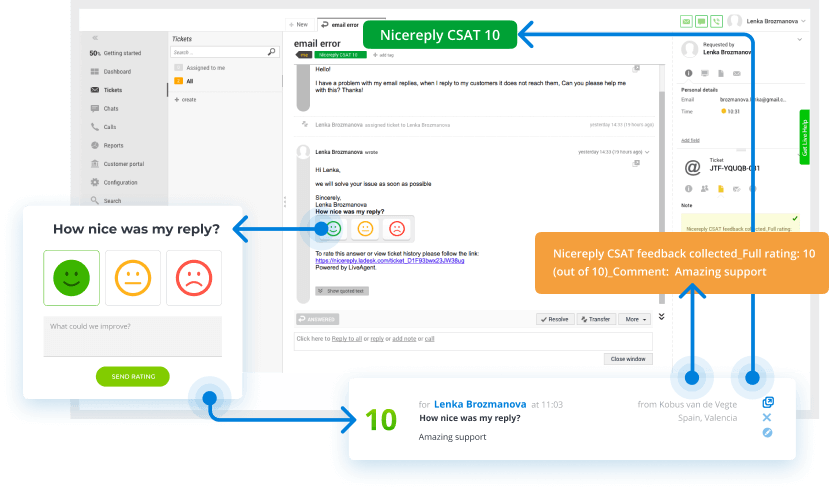
Check ITIL compatibility
ITIL (Information Technology Infrastructure Library) is a widely recognized framework that provides best practices for IT service management. Checking the ITIL compatibility ensures that the tool aligns with industry standards and supports the implementation of ITIL processes in your organization. Here’s why it’s important:
- Consistency: Ensure that your service desk follows established processes and practices outlined by ITIL. This helps standardize your IT service management approach across the organization and ensures consistent delivery of services and support.
- Efficient workflows: ITIL provides well-defined workflows for incident reporting and management, problem management, change management, and other processes. A tool that is ITIL compatible makes it easier to implement and automate these processes, which improves efficiency, reduces manual effort, and ensures adherence to ITIL guidelines.
- Compliance: Many businesses, especially those operating in heavily regulated industries, may be required to comply with specific standards and undergo audits. Implementing ITIL processes can help demonstrate compliance and provide evidence of adherence to industry best practices during audits.
Regularly improve processes
Improving your processes on a regular basis is essential for businesses to stay competitive and meet the changing needs of customers. This is why you should prioritize process improvement and why the tool you choose needs to be adaptable to these changes:
- Continuous improvement: Businesses should strive for continuous improvement to enhance customer satisfaction, adapt to evolving market dynamics, increase employee productivity, and reduce costs. To achieve optimal performance, businesses should regularly evaluate and improve processes that can help identify inefficiencies, eliminate bottlenecks, and streamline workflows.
- Changing needs: As your business grows and the market changes, new challenges arise, and customer expectations change. By constantly improving processes, you can ensure that you will be able to align your support operations or IT service management with these changing needs.
- Flexibility and adaptability: The tool you decide to implement should be able to adapt to your changing processes and requirements. It should come equipped with customization options, workflow flexibility, and scalability to accommodate improvements. This ensures that the tool remains an effective solution even when your operations evolve.
- Collaboration: The software should facilitate seamless collaboration and communication, allowing teams to work together. Look for features like internal notes, collaboration tools, and reporting capabilities that enable effective teamwork and communication.
Conclusion
In conclusion, understanding the difference between service desk vs helpdesk is crucial for businesses to effectively manage their support operations. Help desk tools are focused primarily on customer service and are ideal for businesses that prioritize efficient communication with customers. On the other hand, service desk tools provide a more comprehensive solution, catering to complex IT service management needs within larger enterprises.
Both types of tools offer valuable benefits, such as streamlined communication, efficient workflows, and self-service capabilities. When choosing between these tools, it is important to assess the complexity of your support operations and consider the specific needs of your business. Factors such as the type of industry, business size, growth potential, desired automation capabilities, and ITIL compatibility should be taken into account.
To make the right decision, consider gathering feedback from existing users, reading reviews, and taking advantage of trial periods offered by software providers.
LiveAgent offers a comprehensive and user-friendly help desk software that aligns with the needs of businesses of all sizes. You can try our 30-day free trial and experience the benefits of LiveAgent firsthand. Take the next step to optimize your support operations and deliver exceptional customer experiences.
Struggling to manage customer inquiries efficiently?
Experience the power of LiveAgent's help desk software with our 30-day free trial and provide exceptional customer experiences.
Zagotovite odlične storitve za stranke
Preizkusite LiveAgent – vse-v-enem programsko opremo za podporo strankam. Brezplačno 30-dnevno preizkusno obdobje. Kreditna kartica ni potrebna!
Discover the comprehensive guide to customer support services, essential for enhancing customer satisfaction and loyalty. Learn about the importance of effective communication channels like email, phone, live chat, and social media. Explore the benefits of quality support and how it fosters efficiency and a loyal customer base. Visit our page to delve deeper into customer support strategies and tools.
Svetovalec za podporo strankam
Spoznajte vlogo svetovalca za podporo strankam in odkrijte, kako LiveAgent izboljša zadovoljstvo strank z naprednimi orodji.

 Български
Български  Čeština
Čeština  Dansk
Dansk  Deutsch
Deutsch  Eesti
Eesti  Español
Español  Français
Français  Ελληνικα
Ελληνικα  Hrvatski
Hrvatski  Italiano
Italiano  Latviešu
Latviešu  Lietuviškai
Lietuviškai  Magyar
Magyar  Nederlands
Nederlands  Norsk bokmål
Norsk bokmål  Polski
Polski  Română
Română  Русский
Русский  Slovenčina
Slovenčina  简体中文
简体中文  Tagalog
Tagalog  Tiếng Việt
Tiếng Việt  العربية
العربية  English
English  Português
Português 



